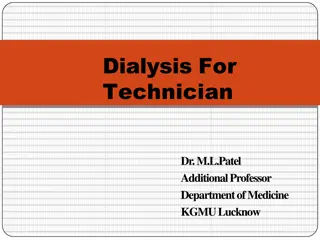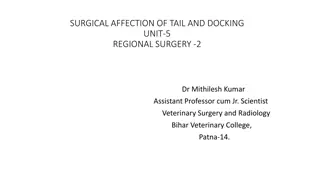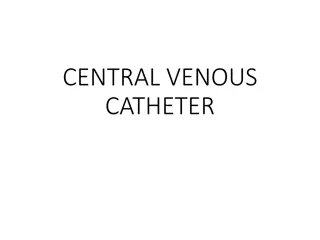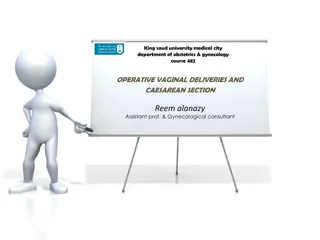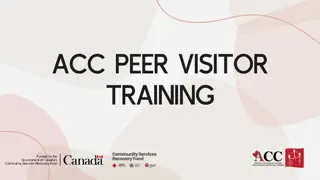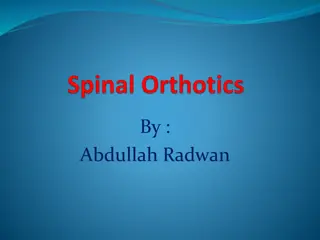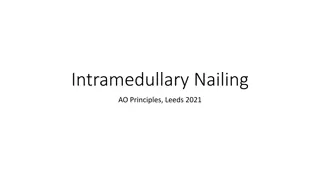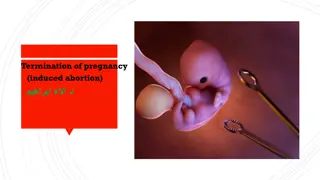Understanding Amputation: Procedures, Indications, and Levels
Amputation is a surgical procedure where part of a limb is removed, commonly in cases of trauma, malignancy, nerve injuries, infections, or severe infections. The process involves levels of amputation based on viability. It is crucial to have a well-healed stump for prosthetic fitting. Different levels include forequarter amputation, shoulder disarticulation, above elbow amputation, below elbow amputation, and Krukenberg amputation. These procedures aim to provide functional outcomes and improve the quality of life for amputees.
Download Presentation

Please find below an Image/Link to download the presentation.
The content on the website is provided AS IS for your information and personal use only. It may not be sold, licensed, or shared on other websites without obtaining consent from the author. Download presentation by click this link. If you encounter any issues during the download, it is possible that the publisher has removed the file from their server.
E N D
Presentation Transcript
Define- Amputation is a procedure where a part of the limb is removed, partly or totally from the body through one or more bones. Amputation is more common in men and more often in the lower limb. DISARTICULATION- Disarticulation is removing the limb through a joint. AMPUTEE- The amputated person is called amputee & the amputated person is that person who has had an arm or leg cut off. STUMP- The extremity of a limb left after amputation is called stump & also called residual limb.
INDICATIONS- Some common indications for amputation are given below- TRAUMA- With an alarming insidence of RTAs, amputation following trauma has become acommon feature. When there is a extensive loss of tissue and disruption of blood supply, no other alternative is left to the surgeon to amputate. MALIGNANT TUMOURS- Amputation is considered for extensive malignancy. NERVE INJURIES AND INFECTIONS- Anaesthastic limbs often develops ulceration, infections and severe tissue damages. EXTREME HEAT OR COLD- Injuries followng electrical burns, accidental burns as well as exposure of limb to extreme cold condition may need amputation. SEVERE INFECTION - Like- gas gangrene or chronic infection.
LEVELS OF AMPUTATION In a limb, an amputation is carried out at a level which give stump an optimum lenght to facilitate subsiquent prosthesis fitting, for eg -for an above knee amputation for the optimum length of the stump is taken as 25cm to 30cm as measured from the tip of the greater trochechanter. The level of amputation is determined by viability of the tissues. Its important that stumps should have a well healed, nontender, supple scar. Its also important that a joint must always be preserved, whenever possible. 1. Forequarter amputation (scapulothoracic amputation) - is carried out proximal to the shoulder joint. It is indicated for malignant bone tumours of the upper end of the humerus. It is a type of a amputation, part of scapula and clavicla are removed along with shoulder girdle muscle. 2. Shoulder disarticulation- is a generally not so popular in the upper limb except at shoulder. Even in disarticulation of the shoulder, the head of the humerus is preserved, wherever possible to maintain the contour of the shoulder.
3. Above elbow amputation (transhumeral amputation)- A 20cm long stump as measured from the tip of the acromion is ideal. 4. Below elbow amputation (transradial amputation)- The optimum length BE stumps a 20cm as measured from the tip of the olecranon process, with a minimum length of 7.5cm. 5. Krukenberg amputation- This is performed in patient usually with bialteral BE amputation who has sufficiently long BE stump. In this, the forearm is split between the radius and the ulna to provide the princer grip. The patient can hold a spoon or lighter object with this fork . For cosmetic purposes and for lifting heavy objects, a BE prosthesis or a hook prosthesis, respectively can be put over this stump.
LOWER LIMB 1. Hind quarter amputation (transpelvic amputation)- It's indicated for malignant tumours at the upper end of the femur or in pelvic bones in this operation, part of the pelvic is removed along with lower extremity. Hip disarticulation- Its the operation where the femur is removed from acetabulam. Above knee amputation (transfemoral amputation)- The optimum length of the above knee stump is about 25cm to 30cm as measured from the tip of GT Below knee amputation (transtibial amputation)- Its the most commonly performed amputatin. The amputation is performed through the legs bones the optimum length of below knee stump is 14cm from the tibial tubercle. 2. 3. 4.
6. Syme's amputation - In this operation, the tibia and the fibula are divided just above the ankle joint. The intact skin over the heal is attached back to the end of stumps with or without part of the calcaneum. Because of the intact heal, it becomes an end bearing stump an the patient manage well walking even bare foot. CRITERIA FOR IDEAL STUMP Ideal length and shape(conical) Bones end well covered with muscle Non adherent incision scar Muscular with good muscle power Absence of neuroma Free from infection Full and free movement at the joint above No fixed deformity
COMPLICATION OF AMPUTATION 1. Phantom pain- In this, the patient feels persistent pain in the non existent, already amputated part of the limb. 2. Painful adhesive scar formation- An adherent painful scar over the surgical incision hinders the fitting of the prosthesis. 3. New born formation at amputation sites-In electrical burn amputee, new born formation has been reported five weeks after amputation. 4. Flexion derformity- The presence of a flexion deformity complicates the process prosthetic fitting and ambulation. 5. Haematoma- Delays wound healing and becomes a site of infection. 6. Infection- Espesially in diabitics and peripheral vascular disease 7. Necrosis- Of skin flaps due to pressure on the distal part of the stump leading to ischaemia 8. Neuromas- At the end of cutaneous nerve.
MANAGEMENT The management can be divided into three stages - 1. Pre-operative stage 2. The early post operative stage 3. The mobility stage 1. Pre-operative stage- It has a following functions- Assessment Pre-operative training Re-assurance
a. Assessment The pre-operative assessment of the effected limb as well as patient as a whole conducted throughly. The R.O.M, muscle power, the condition of skin, status of circulation and sensory index need to be evaluated critically. The overall functional status of the amputee before surgery needs to be analysed and recorded. The other important aspects like age, sex, occupation, general physical status should be observed carefully. Assessment of psychological status is extremely important. Assess the enviroment of the patient's home and his/her working place and the nature of the support he/she is likely to get from friends and relatives.
b. Pre-operative training The pre-operative training program includes- Prevention of thrombosis by maintaining circulation through movements of other good limbs Preventions of chest complication by deep breathing, coughing and postural drainage Preserve mobility of all joints Improved mobility of other related areas like trunk, pelvis or shoulder girdle Each teach the mathodology to be adopted for mobility and limb positioning in bed Educate the patient on the technique of transfer, monitoring the wheelchair, single limb standing and balancing
It is necessary to explain to the patient all the important aspects of the balance, equilibrium, standing and walking techniques The patient should be educated to detect possible complications c. Re-assurance- Psychological re-assurance plays a dominant role in the recovey following amputation. Re-assurance with all possible encouragment is absolutely necessary
2. EARLY POST-OPERATIVE STAGE To check the efficacy of pre-operative training Prevention of contractures and deformities Maintainance of strength and mobility After 3-4days of surgery, stumps exercises can be initiated as active assisted or self resisted exercises in small R.O.M Management of the stumps- Improper management of the stumps is one of the major causes of delayed rehabilitation stump oedema delays
Principles of bandaging the stump The pressure of the bandage should be moderately firm & evenly distributed, decreasing proximally extra pressure in necessary over the corners to obtain a conical shape of stump. Diagnol, oblique or spiral turns should be used while bandaging. In case of an above knee amputation,the bandage must extend upto the grain to prevent a roll of flesh forming over the adductor tendon An above kne stumb should be bandages with knee in slight flexion.
3. MOBILITY STAGE This is a stage of mobilization & restoration of functional independence. It starts with crutch walking at the earliest opportunity. The normal allignment of the pelvis and the reciprocal movements of the stump should be maintain during walking. Elderly patient may need initial ambulation practice in parallel bars. Therefore, functional training with cruches should be given to all hemi-pelvectomy, hip disarticulation and above knee amputees.
MOBILIZATION & STRENGTHENING EXERCISES a. Disarticulation of the arm : Shoulder elevators, depressors, protrectors &retractors. Mobility exercises to the neck & trunk are also important. b. AE amputation : Flexors, abductors & extensors of the shoulder; scapular elevators & retractors on the normal side. c. BE amputation : Elbow flexors, extensors, pronators & supinators of the forearm with mobilization of the trunk. d. Hip disarticulation : Pelvic rotators & elevators. e. Above knee amputation: Hip extensors, abductors, flexore and shoulder girdle muscle f. Below knee amputation: Knee extensors and flexors, hip abductors and extensors
g. Syme's amputation: Same as in below knee amputation R.O.M exercises: Full R.O.M exercises are regularly to the joint proximal to the stump and also to other joint





